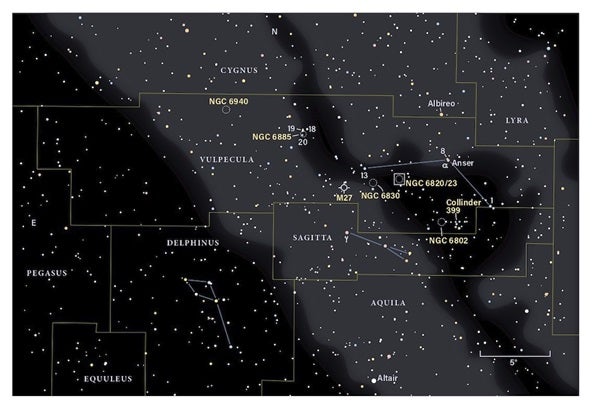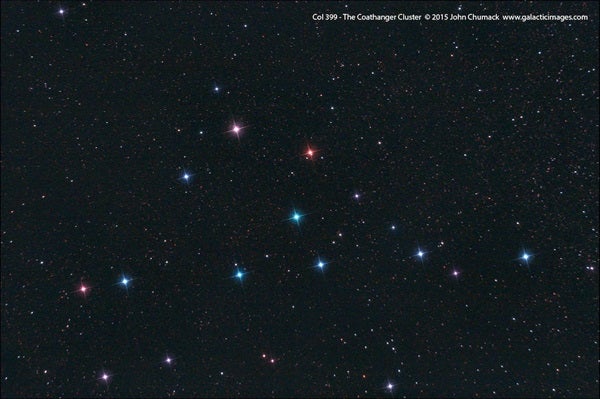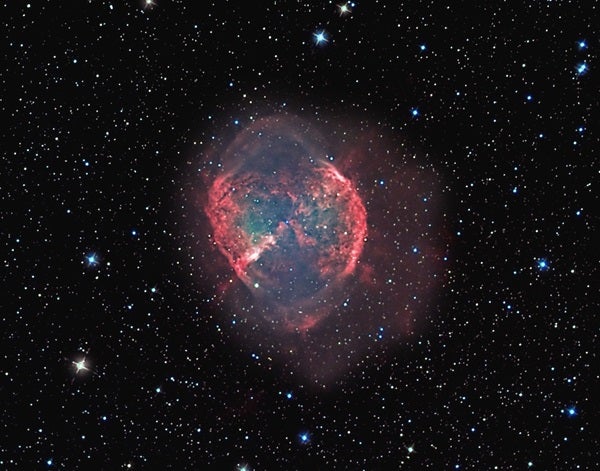A clear and moonless July evening is in the offing, and I’ve decided to turn my attention to the constellation Vulpecula the Little Fox. I’ll opt for a quick naked-eye tour of the celestial critter first, then get up close and personal with my binoculars and telescope.
To be properly prepared, I first scout Vulpecula by studying my copy of Astronomy’s Atlas of the Stars. I also refer to my astronomy guidebooks, consult the internet, and tease through my observing logbooks for sketches and notes on foxy sights I’ve seen in the past. The finder chart on the next page shows the portion of the atlas I’ll be working with. Tonight, the chart will help me navigate my way through the mishmash of faint Vulpecula stars that speckle the summer sky between Cygnus to the north and Delphinus and Sagitta beneath the Little Fox’s southern edge.
Sizing up Vulpecula
Vulpecula will challenge my unaided eye. Not one of its stars is brighter than 4th magnitude. And its brightest star, Anser (alpha [α] Vulpeculae) — the only star in Vulpecula that merits a Greek letter designation — shines at a paltry magnitude 4.4. Fortunately, it’s just 3° south of 2nd-magnitude Albireo (beta [β] Cygni), so I’ll begin my Vulpecula odyssey by dropping down from the Swan to the Fox.
On an average moonless night from my backyard in the suburbs, I can make out naked-eye stars down to about magnitude 5.0. Vulpecula contains only about a dozen stars of that magnitude or brighter. So I’ll test my unaided eyesight by seeing how many I can spot, giving me a general idea of the transparency and steadiness of the atmosphere.
Bust out the binos
Next, with 10×50 binoculars in hand, I’ll go back to Anser. This red giant of spectral class M0 forms a wide optical pair with the 6th magnitude K0 giant 8 Vulpeculae. Both should glow with a golden-yellow hue, but M-class Anser should appear more reddish due to its lower surface temperature.
Another 5° further along the Albireo-Anser line is the pseudo cluster Collinder 399, also known as Brocchi’s Cluster. This target is classified as a pseudo cluster because recent parallax measurements show its component stars lie at different distances from Earth. Brocchi’s Cluster may not be a true open cluster, but its brightest stars form a striking asterism called the Coathanger. The atlas shows this degree-and-a-half-long “hanger,” which is formed by a row of six stars of magnitudes 5 to 7. Branching out from the center of the hanger is a four-star “hook.” I’ve viewed the Coathanger with binoculars many times in the past, and I’ll be back again tonight.
Because much of the western part of Vulpecula is immersed in the Milky Way, it’s also home to several honest-to-goodness open clusters. The atlas shows four of them — NGC 6802, NGC 6830, NGC 6885, and NGC 6940 — plus the emission nebula/cluster complex NGC 6820/6823. I’ve never targeted any of these through binoculars before, but all except NGC 6802 and NGC 6820 should be visible in my 10x50s. NGC 6885 in particular will be a binocular treat. It surrounds the star 20 Vulpeculae and shares the binocular field with 18 and 19 Vulpeculae — a very pretty sight! The Fox’s crowning glory is Messier 27, also known as the Dumbbell Nebula. Brighter (magnitude 7.5) and larger (8′ by 6′) than the typical planetary nebula, the Dumbbell is far and away the most readily visible of them all. I’ll find it by centering my binoculars on the star gamma (γ) Sagittae before shifting my gaze 3° northward. That should bring me to the small, misty patch of light.
Call in the big Dob
Moving on to my 10-inch Dob, I’ll return to Vulpecula’s open clusters. Back in the late 1970s, I viewed NGC 6830, NGC 6940, and NGC 6885 with a 3-inch reflector. They seemed rather faint in that little scope. How much better will they look tonight through the 10-inch?
I’ve never before seen NGC 6802, which lies at the eastern end of the Coathanger. This cluster is just 5′ in diameter, so I’ll locate it with low power, then up the magnification for a better view. The open cluster NGC 6823 is also new to me. At magnitude 7.1 and 12′ across, it should be an easy target. If it looks bright in the 10-inch, I might even try viewing it with my 3-inch. And if I’m successful, I’ll add it to my lifetime list of deep-sky objects that my plucky little telescope has managed to capture. I’ll leave the surrounding nebulosity for the big scope, though, experimenting with various nebula filters if it’s not immediately obvious.
Finally, what better way to end my tour of Vulpecula than to turn my 10-inch scope back to the Dumbbell? I’ve targeted this knotted nebula numerous times over the years, but rarely made in-depth observations with a sizable scope. To do it justice this time, I’ll also have a clipboard, log sheet, pencil, and red-filtered flashlight at the ready, allowing me to make a detailed sketch that I can refer back to at any time — no matter the season or weather.
You may not have quite the same tools at your disposal, but I strongly urge you to replicate any or all parts of my journey through the captivating constellation that is the Little Fox. It’s worth the hunt.
Questions, comments, or suggestions? Email me at gchaple@hotmail.com. Next month: Here come the Perseids! Clear skies!












